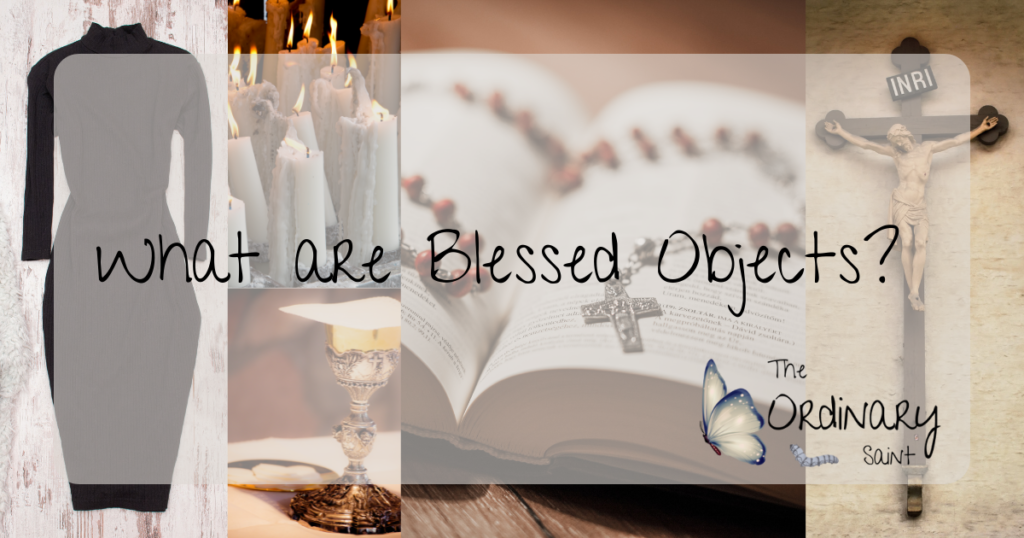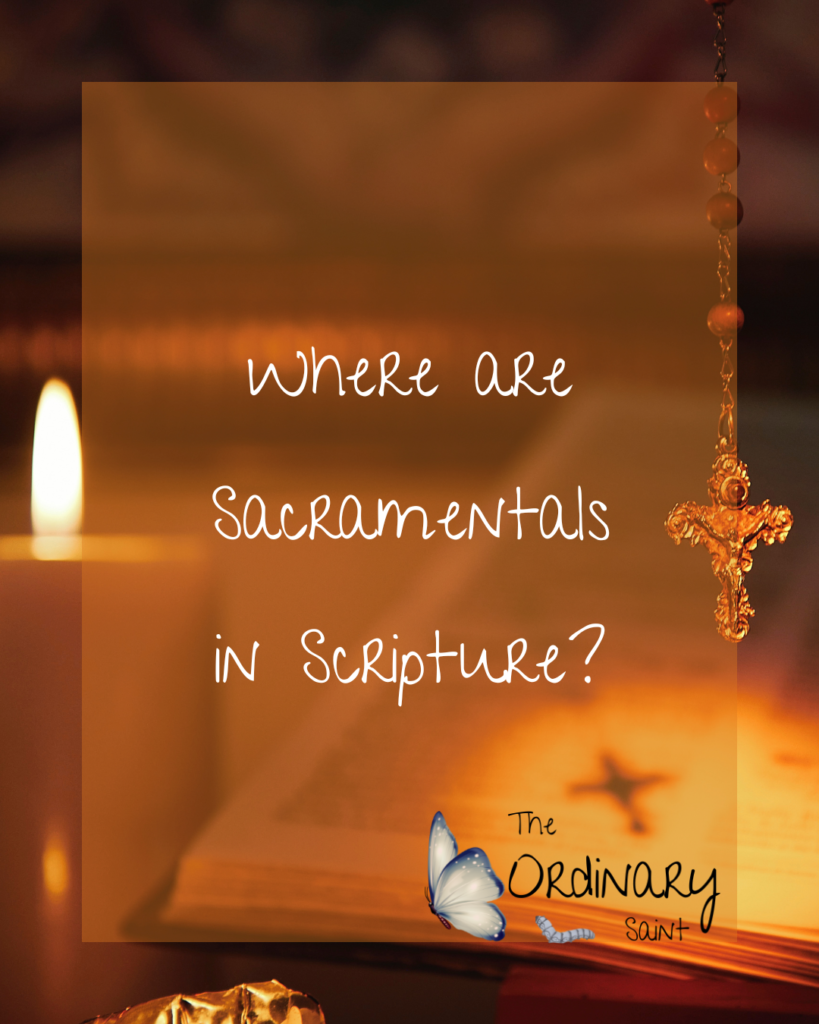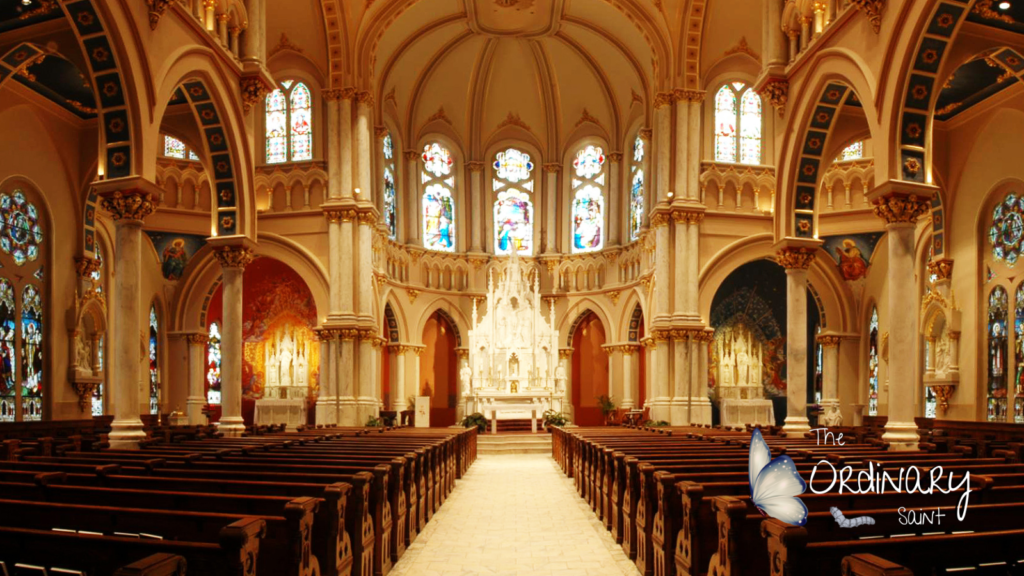
Hi! I am starting with “What We Believe Wednesday”. So here we are with the first of many. I remember going to the wedding of a cousin of mine not long ago. At one point in the ceremony the priest said “Now we will have the blessing of the objects.” I was already Catholic by this point but I had not heard of this and it sounded very strange to me. I had never seen or heard of “blessing of the objects” in any wedding ceremony…ever! I even giggled a little to myself. This was a very modern parish. In fact, if not for the Stations of the Cross on the wall, I wouldn’t even recognize it as being Catholic. “What on earth is this modern voodoo we are doing? Are we creating idols?” I find myself, when I am at a modern Catholic Church, questioning a lot of things. Why is there no tabernacle on the altar? Why is there a set of drums at the back of the church? Why is there no crucifix up front? What are these bizarre banners hanging from the walls? I thought that was a Protestant thing. Let me be clear, the church speaks very clearly against modernism. So unless there is clear and good reason to make a change, tradition is tradition for a reason and should be observed. I am skeptical of anything that feels or appears modern to me. I don’t think this is a bad thing though as it caused me to research, read and pray about it. I learn a lot through this. I won’t get into all of these questions today but I will address blessed items. In celebrating with the saints, I often suggest displaying a blessed holy card or lighting a blessed holy candle of a particular saint while asking for his/her intercession. Unbeknownst to me, this is not modern at all! This is an ancient practice of The Church that I am sad to see is not practiced more and is often abused.
So what are blessed items/blessed objects. Why are we blessing objects? Shouldn’t we bless people instead? These are great questions. Let’s start with: What is a Sacramental?
Sacramentals are holy things or actions of which the Church makes use to obtain for us from God, through its intercession, spiritual and temporal favors.
Whatever visible signs are used by the Church in the worship of God or the promotion of devotion are sacramentals. By these visible signs the benediction of Almighty God is invoked on persons, places, or things, through the intercessory prayer of Holy Mother Church. The prayers of the Church have great efficacy, for they are united to the prayers of Our Lord Jesus Christ and of all the saints.
My Catholic Faith A Catechism in Pictures
A “Blessed object” or “Blessed item” is a sacramental. Sacramental refers both to the blessing given as well as the object which carries the blessing for the benefit of the individual. We believe that these sacramentals help us in our faith and our walk with Jesus. I know what you are thinking… “Wait! This is superstitious. I thought that was against church teaching.” You are half right. Being superstitious is prohibited as a Catholic.
If we use sacramentals, as they should be used, in acknowledgment of our faith in the efficacy of the blessing of the Church which God Himself founded, our act will be most pleasing to God, and the sacramentals will profit us greatly. If we wear a crucifix or medal on our persons, hoping that by God’s grace it will preserve us from evil, we are not superstitious.
We must remember, however, that of themselves sacramentals have no power. They only have power through the prayer of the Church which uses the authority given by Christ.
My Catholic Faith A Catechism in Pictures
Some common sacramentals are holy water, candles, rosaries, scapulars, holy oil, salt, crucifixes, holy images of Jesus, Mary, and the Saints, bibles, medals of saints, ashes, and palms. The benefits of using sacramentals is receiving grace, forgiveness of venial sins, remission of temporal punishment, health, and protection from evil spirits, amongst others.
The blessing given by the Church makes holy water of special efficacy. We should always make the sign of the cross, whenever possible with holy water; by it we would gain one hundred days’ indulgence.
My Catholic Faith A Catechism in Pictures
Where are Sacramentals spoken of in Scripture?

Acts 19:11-12 We read about how garments which touched Jesus were used to heal and exorcize others because they carried the blessing he bestowed upon it.
“And God did extraordinary miracles by the hands of Paul, so that handkerchiefs or aprons were carried away from his body to the sick, and diseases left them and the evil spirits came out of them.”
“You shall serve the LORD your God, and I will bless your bread and your water; and I will take sickness away from the midst of you.” Exodus 23:25
There are also many passages about blessing yourself and others with the sign of the cross as a means of devotion and protection. Here are a couple of examples:
“Then I looked, and behold, on Mount Zion stood the Lamb, and with him a hundred and forty-four thousand who had his name and his Father’s name written on their foreheads.” Revelation 14:1
“Do not harm the earth or the sea or the trees, until we have sealed the servants of our God on their foreheads.” Revelation 7:3
So how does one use a Blessed object?
Many people bless their rosaries which they then pray the rosary with. Blessed Candles remind us of our prayers rising to Heaven just as the smoke rises. It also symbolizes that we are the light of the world. I like to light a holy candle as I read sacred scripture or have prayer time. Wearing a blessed medal of one of your favorite saints is a great way to keep him/her in mind and ask for their intercession throughout your day. When I bought my home I walked the perimeter of my home sprinkling blessed salt as I prayed for the protection of my home and all those who would enter within its walls. I like to do this once a year. I was fascinated to learn that women would often bless their dresses and wear them in honor of Mother Mary under the devotions of Our Lady of Lourdes, our Lady of Sorrows, our Lady of the Immaculate Conception, our Lady of Mt. Carmel and Mary Help of Christians. They were also worn in honor of St. Joseph, and of St. Anthony. Blessed dresses were a reminder for girls to dress modestly always. They were also worn as a promise, perhaps to remain modest and chaste, or to be a faithful wife; or to obtain a special favor. If a woman wore a blessed dress to obtain a special favor and did not fulfill her promise, this was not punishable under the penalty of sin. She would simply fail to receive the grace or favor she was asking for but would not incur sin on her part.
So now the blessing of rosary boxes and bibles at a wedding makes a lot more sense. Please be aware, however, there are important do’s and don’t for sacramentals or blessed objects.
- Once an object has been blessed it may never be sold or traded for money or personal gain. Doing so would not only remove the blessing but also be an instance of grave sin for both the buyer and the seller as blessings can never be sold or purchased. Exceptions to this are homes and cars which are not religious items but are blessed while you own them. Once sold the blessing is considered to be removed (without sin) and may be released by the new owners. However Sacramentals which are religious in nature, ie: rosaries, medals, oils, scapulars, holy images, etc., do fall under this rule.
- Sacramentals and blessed objects are not to be used as objects of superstition. Superstition is strictly forbidden in the Christian faith as it takes the recognition of power away from God and assumes it on an object or set of circumstances. All power comes from God and God alone! The Catechism clearly tells us that we do not always obtain the favor we ask for by the use of sacramentals (it is sometimes not to the benefit of our soul or salvation to obtain what we ask for) but no earnest prayer is ever offered in vain. If God does not will us to have what we ask for, He will grant us something even greater.
- Once an object has been blessed it may never be thrown away but should always be treated in a respectful manner. If a sacramental has been broken beyond repair, it is considered to no longer be blessed but should ideally be respectfully buried in a safe place.
“Blessed sacramentals” are religious objects that are blessed, such as rosaries, medals, crucifixes, etc. These are not technically “sacred objects” in the sense of being set apart for “divine worship” (liturgy) but are meant for prayer, piety, or private devotions. In the July 12, 1847, Decree of the then-Sacred Congregation of Indulgences & Sacred Relics, the Congregation explicitly prohibited the selling of rosaries and crucifixes. It added that, if sold, these lose the blessings and indulgences attached to them. Similarly, the Raccolta (1910) repeats this prohibition stating “they cannot be sold or exchanged” (Raccolta, #38).
Inevitably, the sale of blessed sacramentals easily causes scandal. In all prudence, the sale should be of a non-blessed religious object and should be blessed only after the sale.
Adoremus.org
There is a common practice amongst homeowners when selling a home that they will purchase a small statue of St. Joseph, bury it upside down in the backyard as they pray for the fortunate sell of their home. This should be discouraged. This is NOT a respectful manner of burial and is also leaning toward superstitious. I hardly think St. Joseph would much appreciate upside down burial.
I could not find where this tradition started but I do personally believe there is a respectful manner to carry out this tradition.
What can you do instead?
Purchase a St. Joseph statue or use one you already have. You might even ask a friend if they might loan you one of theirs. Take it to be blessed by a priest then bring it home and respectfully and prayerfully bury the statue in the backyard (upright) while asking St Joseph to intercede for you for the blessed sell of your home. The morning of closing, dig up your statue, dust him off and take him to your new home and place him in a place of honor such as the mantle or home altar or return him if he was borrowed. It would be nice to also take a thank you gift to whomever loaned him to you. Remember to thank St. Joseph often in prayer.
You may also chose to pray a novena to St. Joseph without the presence of a statue.
Conclusion
Sacramentals are a wonderful blessing to us and direct our thoughts, prayers, and actions to God while always respecting the object because of the blessing it carries. Comment below and share with me a couple of your favorite Sacramentals.
Links for More Reading
https://adoremus.org/2022/01/q-is-selling-or-buying-a-blessed-object-permitted/
https://bismarckdiocese.com/news/what-happens-to-an-object-when-it-is-blessed
https://www.philipkosloski.com/where-in-the-bible-are-sacramentals/
DISCLOSURE: This post is not sponsored or affiliated with any business, entity, or product. I am receiving no money or other compensation for this content.

